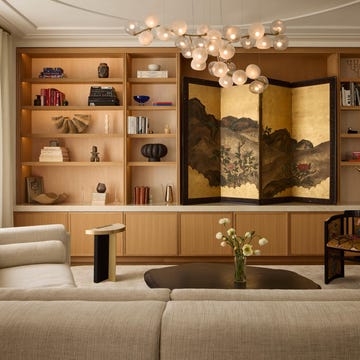The 1970s were radical and beautiful, ushering in a period of experimentation in culture and design; Stairway to Heaven dropped, the Ramones formed, Jaws, The Godfather, Star Wars and The Muppets Show all debuted, and a man called Steve Jobs launched Apple Computer, Inc.
Emily, an artist and technical writer, and Javier, a software engineer, wanted to emulate this progressive decade in the look and feel of the family home they share with their two children – Julian, 12, and Eva, eight. ‘I am a child of the 70s,’ says Emily. ‘It is my favourite era: the fashion, furniture, the unapologetic over-the-topness of it all. We used to dance to the Bee Gees around a modular sofa, which we rearranged to suit our moves.’
The couple hired Marmol Radziner to help them rework their 1953 property, set into the lower ridges of California’s verdant Tamalpais Valley.
What's everyone reading?
The Los Angeles-based architects – renowned for blurring the lines between indoor and outdoor living – opened up rooms, expanded windows and elevated the family room, dining area and kitchen by adding a vaulted ceiling to encourage views of the garden’s majestic 200-year-old sequoia.
The main bedroom was redesigned as a glass box that hovers over the backyard and a new guesthouse was also built.
The architecture wasn’t the only thing to get an overhaul, though. The interiors have also seen a shift from a mid-century aesthetic to the more sensual and earthy 1970s look – a transformation overseen by Alexis Tompkins and Leann Conquer of San Francisco interior-design agency Chroma.
‘We did all kinds of historical research,’ says Alexis, ‘going deep into the music, film and fashion to create a holistic narrative, referencing the curved furnishings, colour palettes and textures, then pulling them through our lens to make the style fresh, not simply a time capsule.’
The balance between vintage and current, curvaceous and linear, was a fine one that Alexis and Leann were constantly refining. ‘There was a continuous dialogue between the historic and modern,’ says Alexis. ‘We were always recalibrating.’
In the family room, that meant a curated mix: a caramel-coloured, modular Mario Bellini sofa, François Monnet lounge chair – both 1970s classics – and a side table by Luca Nichetto, placed alongside bespoke Chroma pieces and a coffee table inspired by the work of Karl Springer, the Berlin-born American designer of the disco era.
For Emily, who wanted ‘every room to feel comfortable, with a tinge of glamour’, the combination could not be more perfect. It’s playful and infused with the sexy swagger that defined the decade, but with a 21st-century perspective – ready for a new generation’s living-room dance moves. chromasf.com; marmol-radziner.com



















